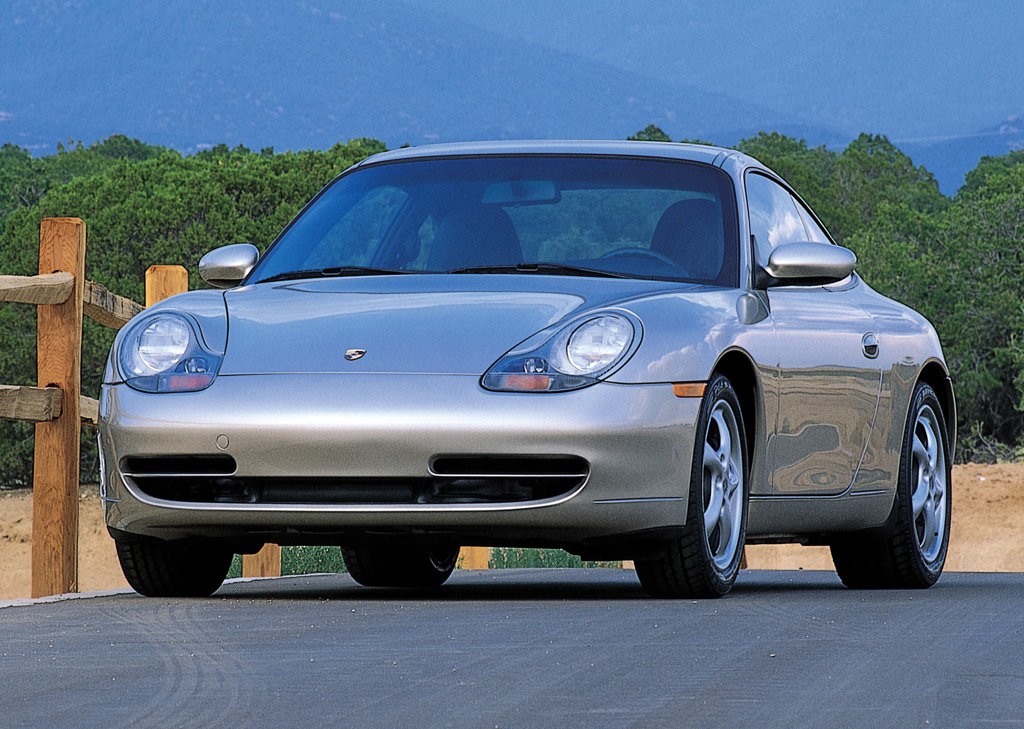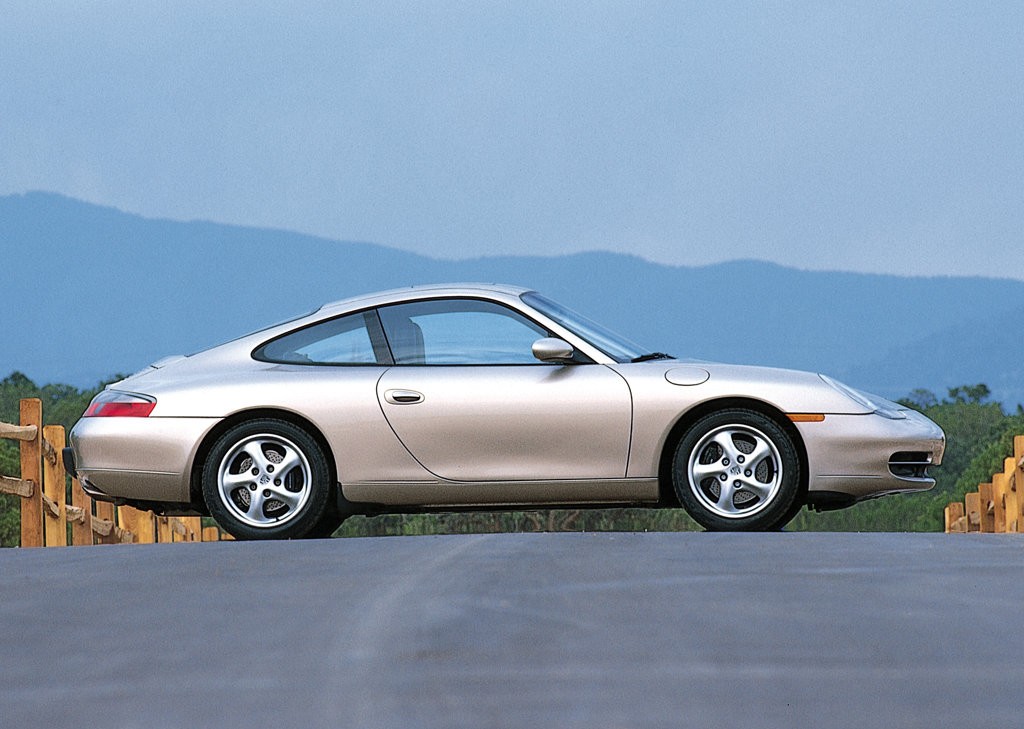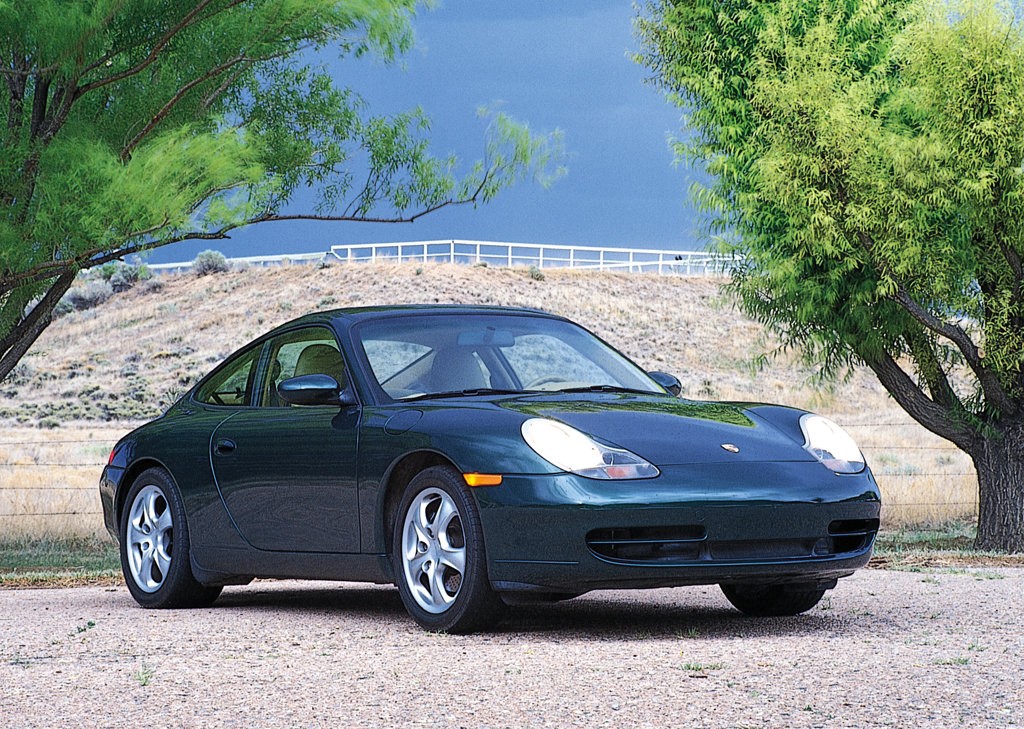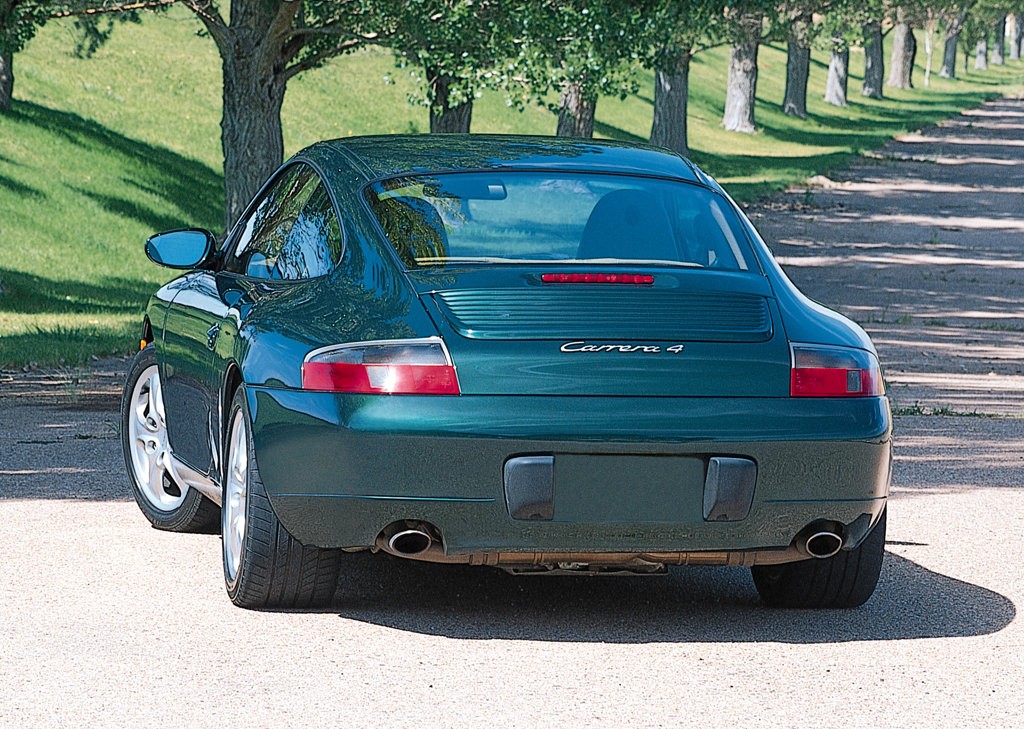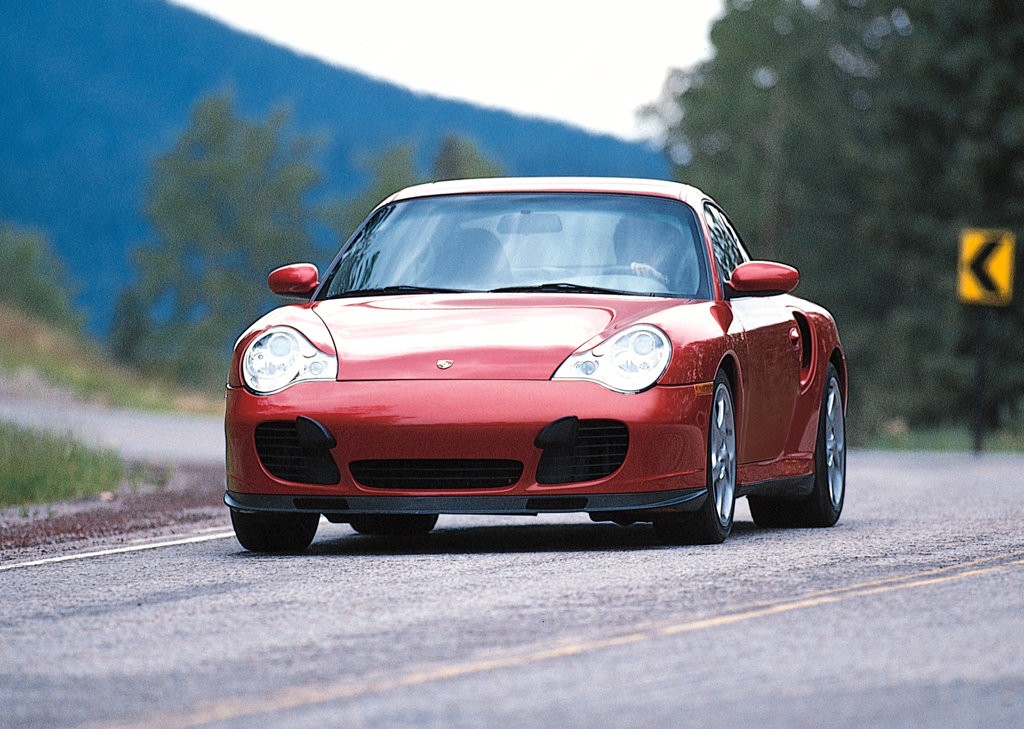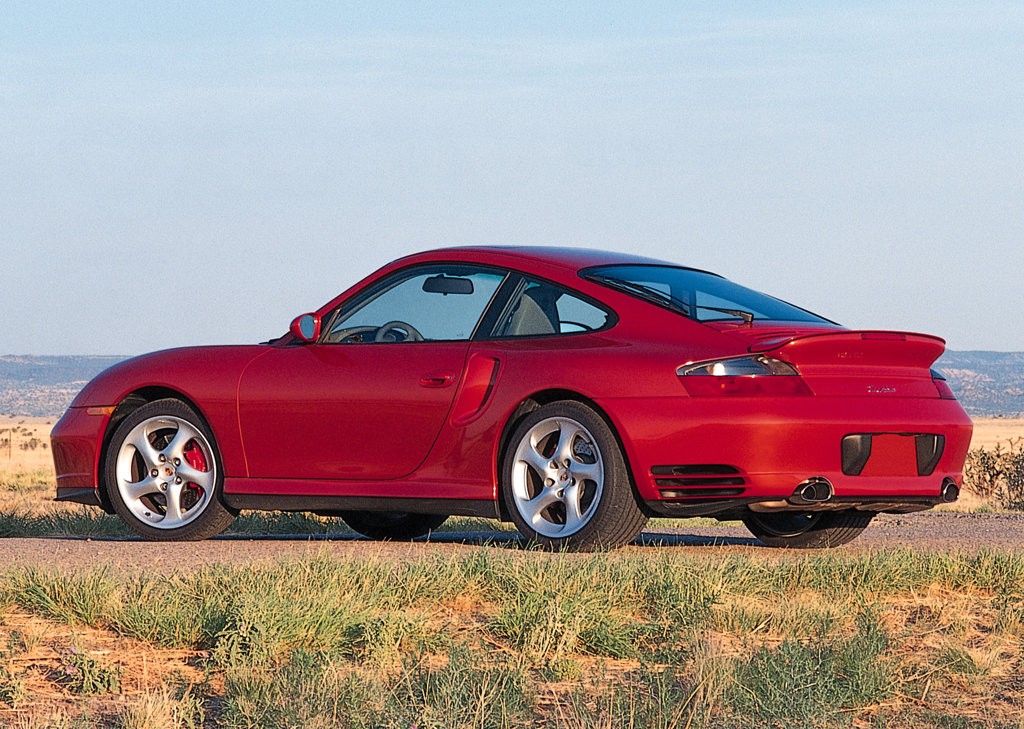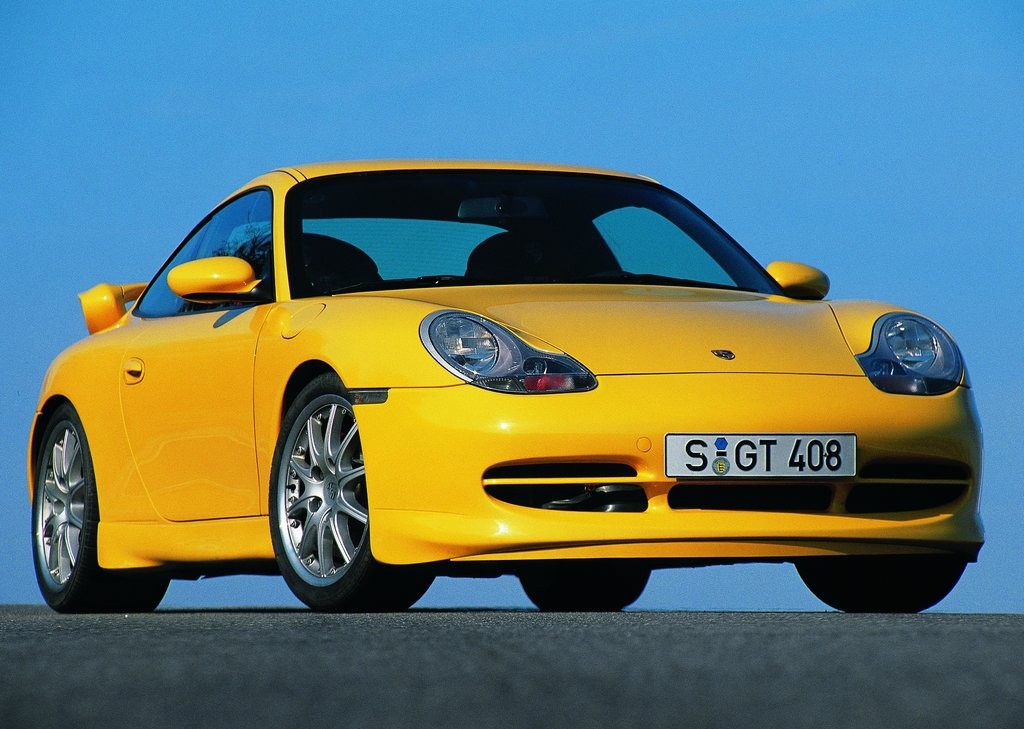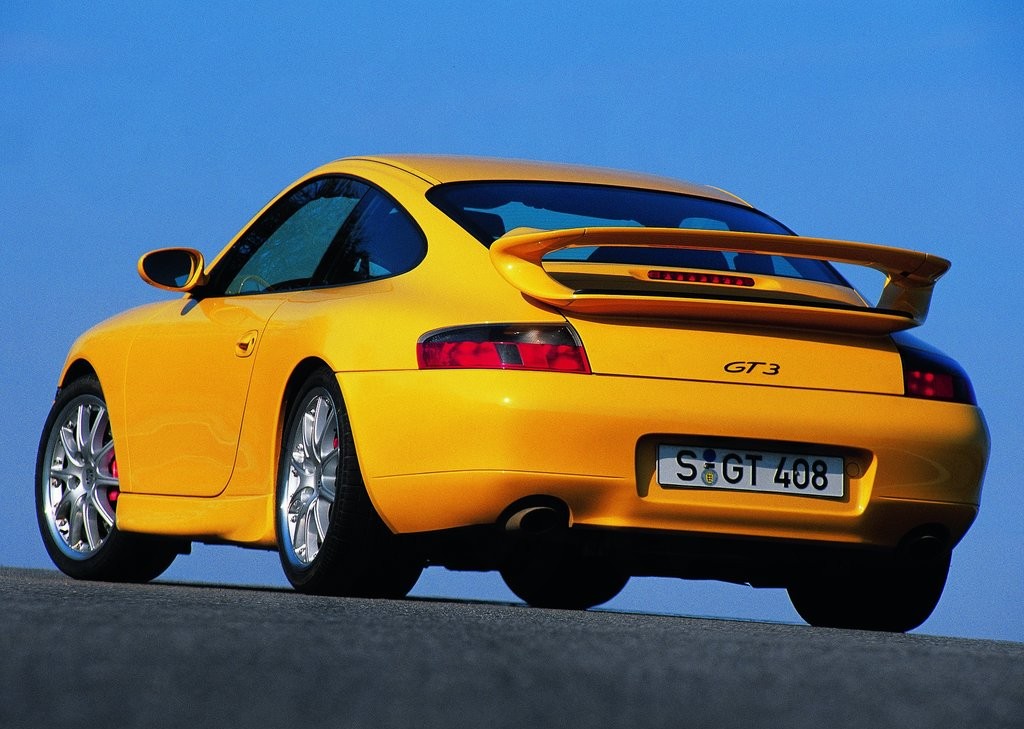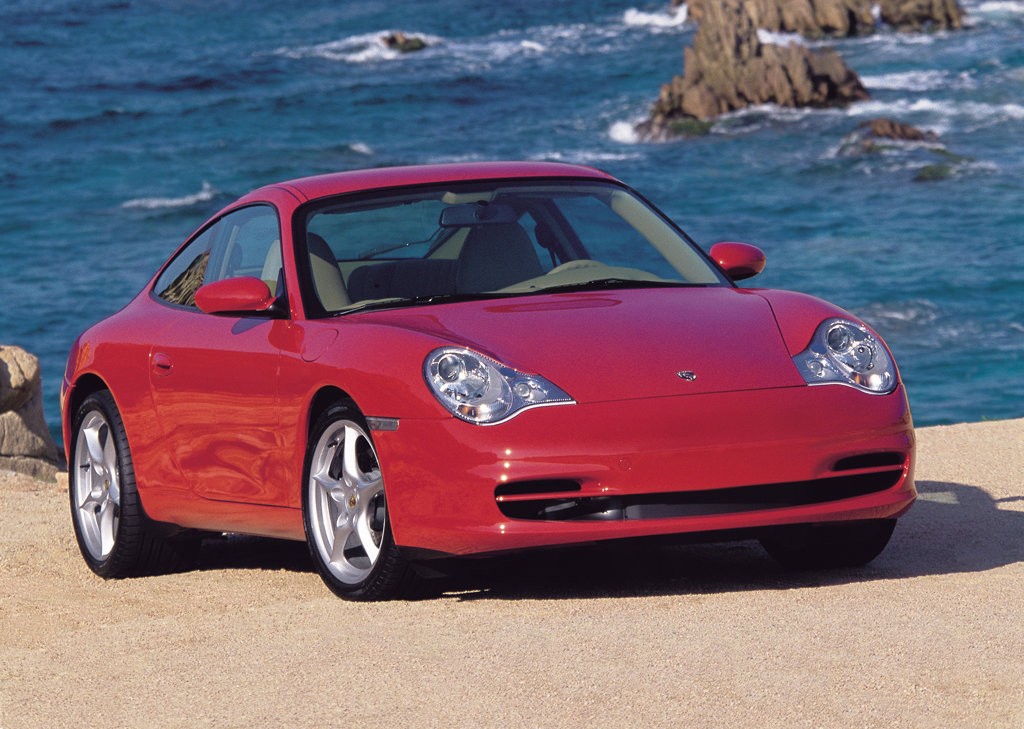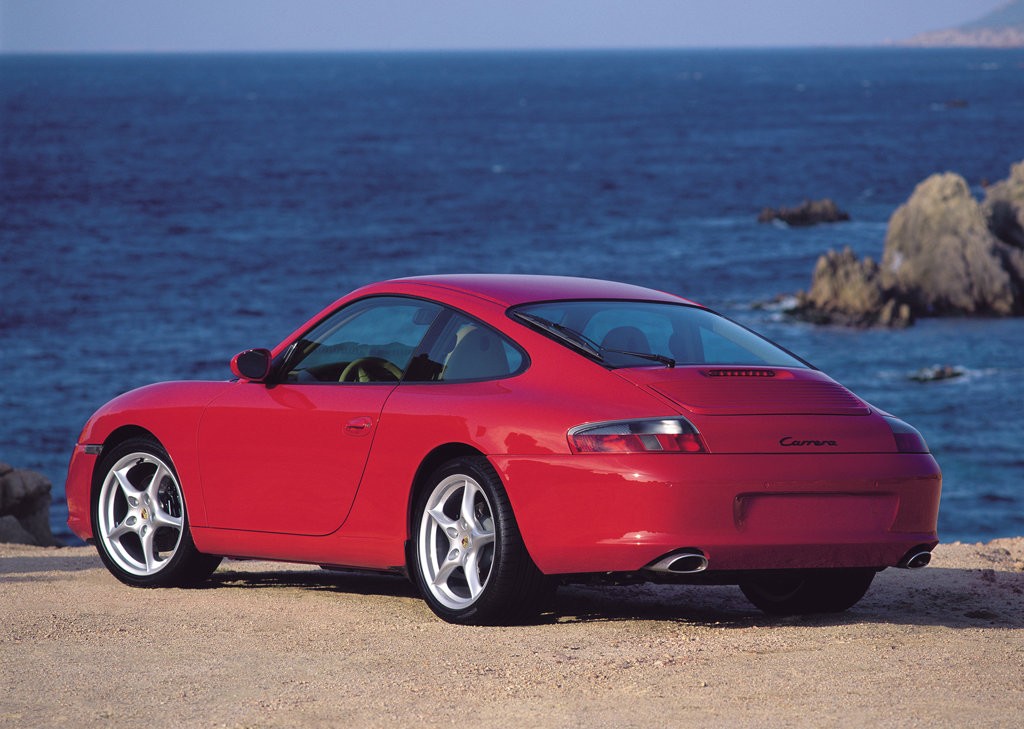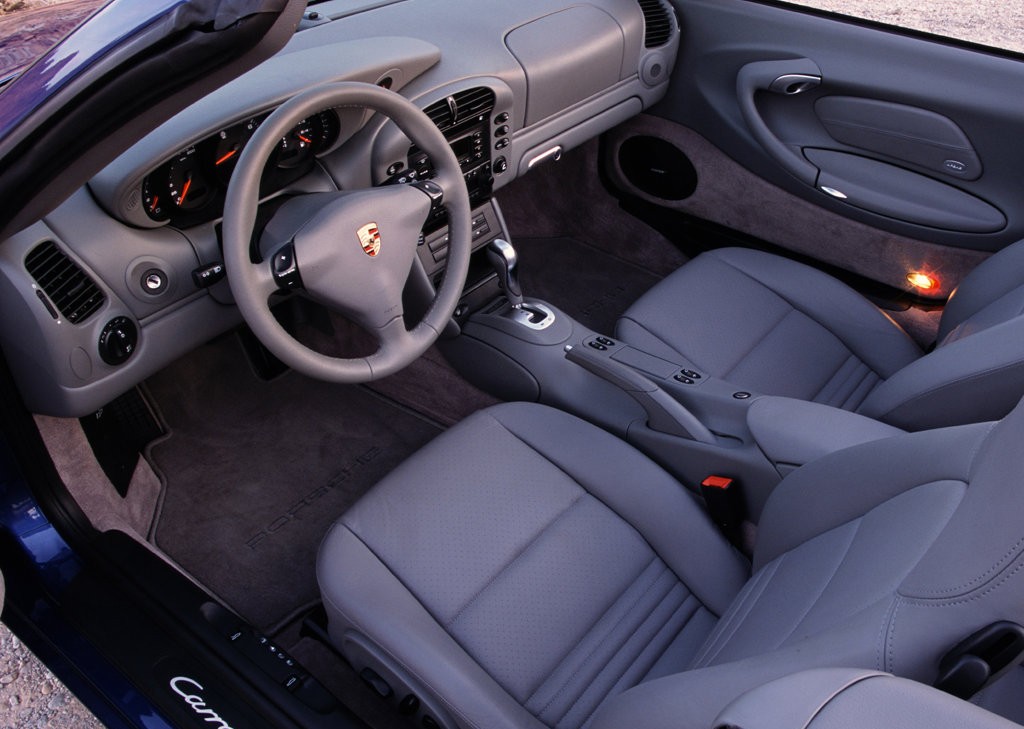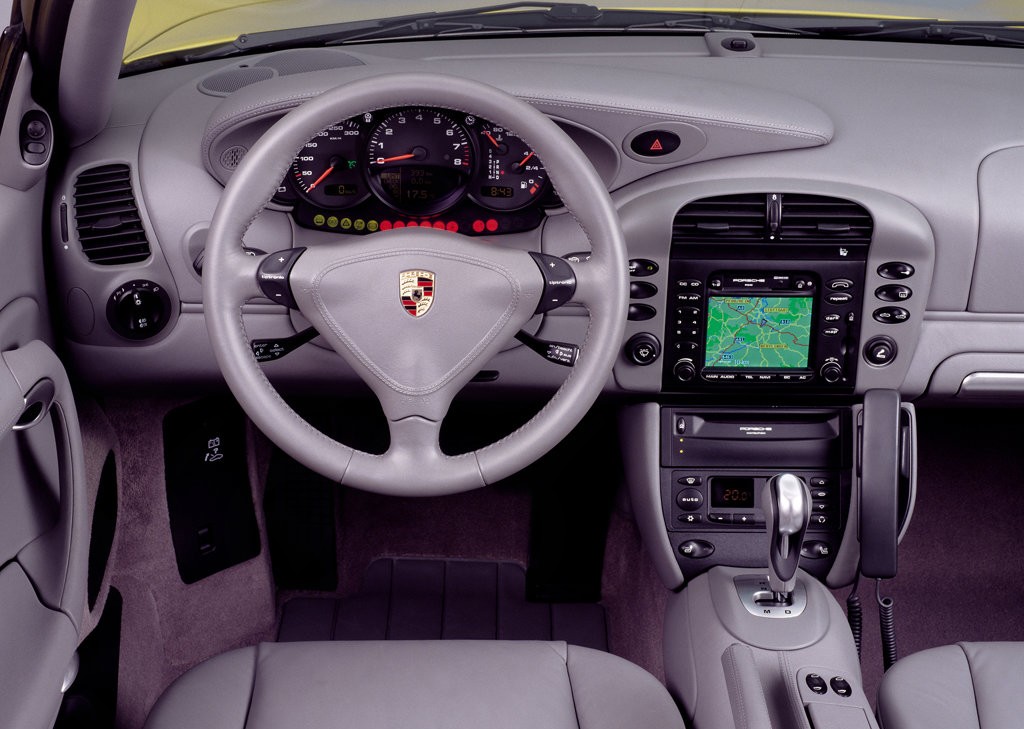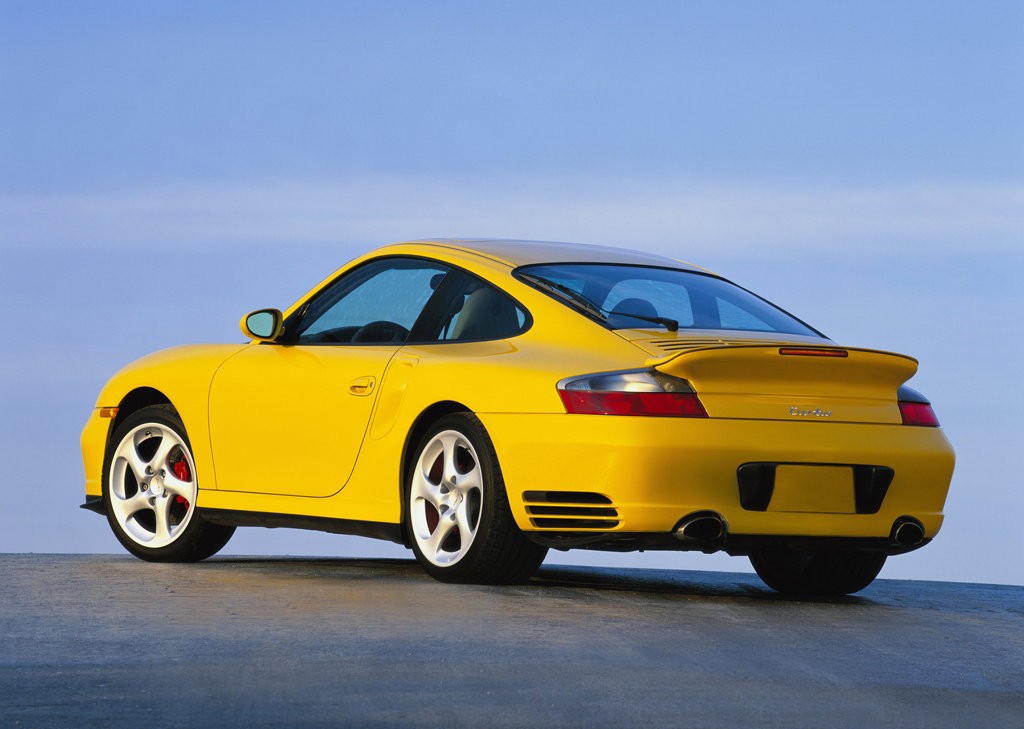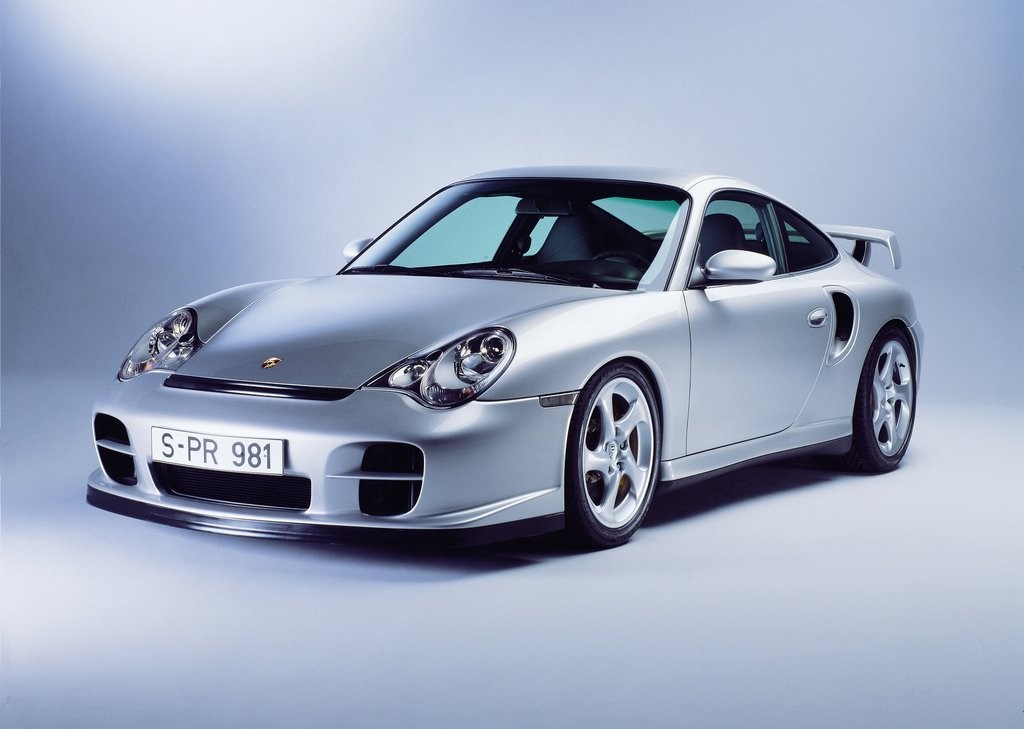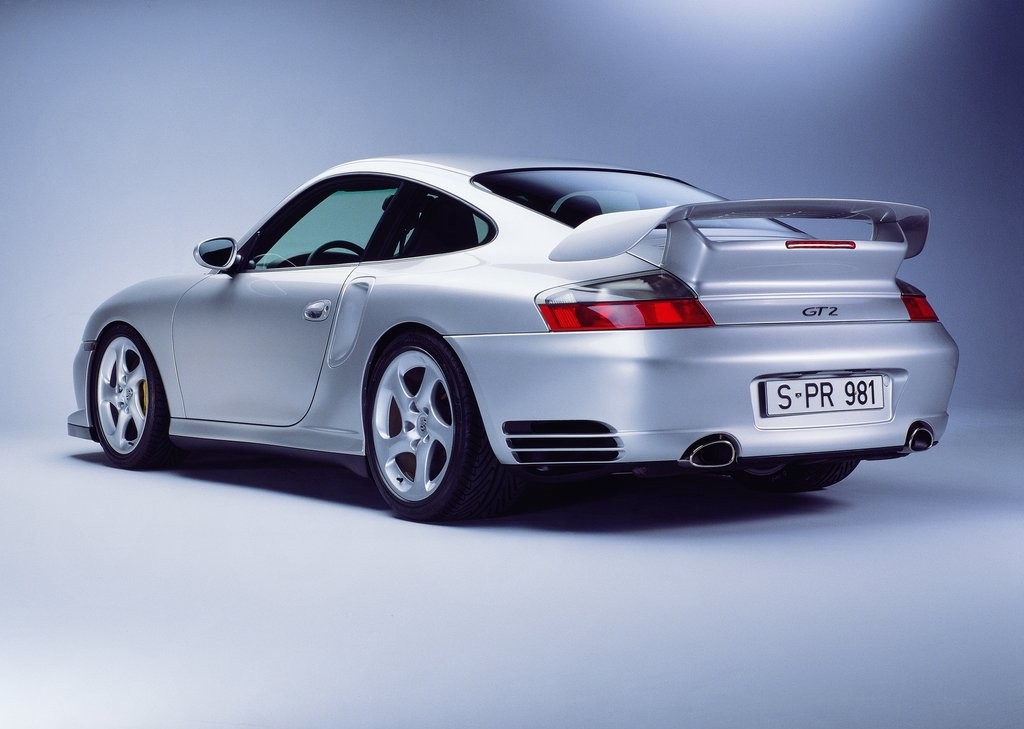
- Free-revving flat six-cylinder engines sing sweetly
- Impressive dynamics
- Well-weighted steering provides excellent feel
- Responsive brakes
- Front seats provide excellent lateral support…
- … but are narrow around the shoulders
- Suspension lacks compliance
- For manual transmissions, stiff clutch
- Tiptronic transmission blunts performance
- Cramped rear seats
- Intermediate Shaft (IMS) bearing susceptible to failure
Review: Porsche 996.I 911 Coupe (1998-01)
Overview
Released in January 1998, the Porsche 996 Series I (996.I) 911 Coupe was a two-door fastback. Manufactured in Stuttgart, Germany, the 996 911 Coupe range initially consisted of the rear-wheel drive Carrera variants, with the all-wheel drive Carrera 4 following in December 1998. The range was further expanded with the GT3 in September 1999 and Turbo in December 2000. The full range is given in the table below.
Engines
The Carrera and Carrera 4 were powered by 3.4-litre flat (or horizontally opposed) six cylinder engines had liquid-cooling (previously air cooled), dry sump lubrication, double overhead camshafts, four valves per cylinder, Porsche’s VarioCam Plus intake valve timing and lift system, and compression ratios of 11.3:1. The track-oriented 911 GT3, however, was powered by a larger 3.6-litre engine which featured cylinder heads made of RR 350 light alloy, titanium connecting rods and specially treated crankshaft.
The 911 Turbo had a 3.6-litre engine which featured parallel K24 turbochargers that provided peak boost pressure of 0.9 bar (13 psi); the compression ratio was also reduced to 9.4:1.
Dimensions and body
Compared to the 993 911 Coupe , the 996 911 Coupe was 185 mm longer (at 4430 mm), 30 mm wider (1765 mm), 5 mm taller (1305 mm) and had a 78 mm longer wheelbase (2350 mm). In addition to greater interior space, torsional stiffness increased by 49 per cent and bending stiffness by 82 percent.
Suspension
The 996 911 Coupe had MacPherson strut front suspension with aluminium lower control arms and five-link rear suspension which was mounted to an aluminium subframe.
| Variant | Years | Drive | Engine | Trans. | Peak power | Peak torque |
|---|---|---|---|---|---|---|
| Carrera | 1998-01 | RWD | 3.4-litre M96.01 petrol F6 | 6sp man., 5sp auto |
221 kW at 6800 rpm | 350 Nm at 4600 rpm |
| Carrera 4 | 1998-01 | AWD | 3.4-litre M96.01 petrol F6 | 6sp man., 5sp auto |
221 kW at 6800 rpm | 350 Nm at 4600 rpm |
| GT3 | 1999-00 | AWD | 3.6-litre M96.76 petrol F6 | 6sp man. | 265 kW at 7200 rpm | 370 Nm at 5000 rpm |
| Turbo | 2000-01 | AWD | 3.6-litre M96.70 twin-turbo petrol F6 | 6sp man., 5sp auto |
309 kW at 6000 rpm | 560 Nm at 2700 rpm |
AWD system
The Carrera 4, GT3 and Turbo variants were fitted with an all-wheel drive which utilised a viscous multi-plate clutch behind the front differential. In normal conditions, only five per cent of the engine’s torque was directed to the front axle. If wheel slip occurred, however, the viscous coupling would act to direct up to 40 per cent of the engine’s torque to the front axle.
Safety equipment
Standard safety equipment for the 996 911 Coupe included dual front airbags, front seat-mounted side airbags (providing head, chest and hip protection) and ABS.
The all-wheel drive models were further equipped with Porsche’s Stability Management (PSM) system which consisted of traction control and electronic stability control.
Brakes
The 911 Carrera and Carrera 4 had 318 mm by 28 mm front brake discs and 299 mm by 24 mm rear discs with four-piston monoblock brake calipers. The Turbo and GT3 had the same monoblock calipers, but were fitted with 330 mm by 34 mm front discs and 330 mm by 28 mm rear discs.
Features: 911 Carrera and Carrera 4
Standard features for the Carrera included 17-inch alloy wheels (with seven-inch wide 205/50 ZR17 front and nine-inch wide 255/40 ZR17 rear tyres), a ten speaker sound system with CD player, climate control air conditioning, leather seats, power adjustable front seats, cruise control, front fog lights, leather-wrapped steering wheel and gearshift, remote central locking, power windows and mirrors, a power sunroof telescopic steering wheel adjustment, a trip computer, alarm and immobiliser.
Porsche 996 911 GT3
The Porsche 996 911 GT3 was fitted with 18-inch light-alloy wheels with 225/40 ZR18 front and 285/30 ZR18 rear tyres and a limited slip rear differential. Furthermore, the GT3’s suspension system had adjustable anti-roll bars, was compatible with racing springs and had an extended range of axle geometry adjustment for the use of racing tyres.
To reduce mass, the track-oriented GT3 omitted some of the standard Carrera features such as the sound system and power adjustable seats. The GT3 could accelerate from rest to 100 km/h in 4.8 seconds and had a top speed of 302 km/h.
Features: 911 Turbo
Compared to the Carrera variants, the Turbo was equipped with 18-inch alloy wheels with eight-inch wide 225/40 ZR18 front tyres and eleven-inch wide 295/30 ZR18 rear tyres and bi-xenon headlights.
Visually, the Turbo variants could be identified by their different headlights, larger intake grills, flared fenders, widened rear stance, distinctive rear spoiler and red-painted brake calipers. Inside, the Turbo variants also had a different instrument panel with an on-board computer displaying information via an LCD in the tachometer.
Review: Porsche 996.II 911 Coupe (2001-05)
Overview
Released in August 2001, the 996 Series II (996.II) 911 Coupe introduced 3.6-litre engines for the Carrera variants and VarioCam Plus valve timing and lift system was revised to provide continuously adjustable valve timing. The Carrera variants were also fitted with the Tiptronic S transmission from the 996.I 911 Turbo which was rated for higher torque applications than the previous automatic transmission; the Tiptronic S had a sequential shift mode in which gearshifts could be controlled via steering wheel-mounted thumb switches.
Visually, the 996.II 911 Coupe could be identified by its new headlights (previously introduced with the 996.I 911 Turbo), revised front end, widened rear quarter panels and redesigned oval exhaust outlets; the polycarbonate rear window was also replaced with a glass rear window with integral defroster. Furthermore, changes to the body improved cooling of the brakes, radiator and transmission cooling, while also reduced lift.
Inside, the instrument panel from the 996.I 911 Turbo was adopted throughout the range; other changes included a three-spoke steering wheel, redesigned centre vents, lockable glove box and cup holder integrated in the centre of the dashboard.
| Variant | Years | Drive | Engine | Trans. | Peak power | Peak torque |
|---|---|---|---|---|---|---|
| Carrera | 2001-05 | RWD | 3.6-litre M96.03 petrol F6 | 6sp man., 5sp auto |
235 kW at 6800 rpm | 370 Nm at 4250 rpm |
| Carrera 4 S | 2001-05 | AWD | 3.6-litre M96.03 petrol F6 | 6sp man., 5sp auto |
235 kW at 6800 rpm | 370 Nm at 4250 rpm |
| Turbo | 2001-05 | AWD | 3.6-litre M96.70 twin-turbo petrol F6 | 6sp man., 5sp auto |
309 kW at 6000 rpm | 560 Nm at 2700-4600 rpm |
| Turbo S | 2005 | AWD | 3.6-litre M96.70 twin-turbo petrol F6 | 6sp man., 5sp auto |
331 kW at 5700 rpm | 620 Nm at 3500-4500 rpm |
| GT2 | 2001-04 | RWD | 3.6-litre M96.70 twin-turbo petrol F6 | 6sp man. | 340 kW at 5700 rpm | 620 Nm at 3500-4500 rpm |
| GT3 | 2001 | AWD | 3.6-litre M96.79 petrol F6 | 6sp man. | 280 kW at 7400 rpm | 370 Nm at 5000 rpm |
| 2003-05 | AWD | 3.6-litre M96.79 petrol F6 | 6sp man. | 280 kW at 7400 rpm | 385 Nm at 5000 rpm |
Safety equipment
Compared to its 996.I predecessor, standard safety equipment for the 996.II 911 Carrera was extended to include front seatbelt pretensioners and load limiters. Porsche also claimed that the body structure was strengthened.
Features: 911 Carrera
Compared to its 996.I predecessor, standard features for the 996.II 911 Carrera were largely unchanged.
Features: 911 Carrera 4 S, Turbo and Turbo S
Compared to the Carrera, the Carrera 4 S was fitted with 18-inch alloy wheels and had a 60 mm wider rear end to accommodate its 295/30 R18 rear tyres. Visually, the Carrera 4 S and Turbo could be identified by their three large, dark-finish intake grilles and red-painted brake calipers. The Carrera 4 S also had a glass-reinforced plastic rear deck lid with a reflector strip between the tail-lights.
The Turbo was further equipped with an eleven speaker Bose sound system with six-channel amplifier, bi-xenon headlights with washers, rain-sensing wipers and an electrochromatic rear view mirror.
The Turbo S was fitted with the optional X50 engine enhancement package that had been previously available for the Turbo, resulting in 22 kW and 60 Nm increases to peak power and torque. The Turbo S was also fitted with a ceramic composite braking system which included cross-drilled 350 mm front and rear brake discs. The Turbo S also had unique bodywork for enhanced aerodynamics and improved engine and brake cooling.
2001 Porsche 911 GT3 and 911 GT2
Compared to its 996.I predecessor, the 996.II 911 GT3 was largely unchanged. Like the GT3, the performance-oriented GT2 had an adjustable suspension system and omitted some of the standard Carrera features such as the sound system and power adjustable seats. The rear-wheel drive GT2, however, was fitted with 235/40 R18 front and 315/30 R18 rear tyres, leather-covered glass-fibre bucket seats and a ceramic composite braking system (as per the Turbo S). The GT2 could accelerate from rest to 100 km/h in 4.1 seconds and had a top speed of 315 km/h.
2003 911 Carrera 40thAnniversary edition
In November 2003, 40thAnniversary edition Carreras were released. Engine modifications increased peak power and torque to 254 kW at 6800 rpm and 370 Nm at 4800 rpm, while safety equipment was extended to include electronic stability control and traction control. The 40th Anniversary editions were also fitted with 18-inch shot-blasted and polished alloy wheels, bi-xenon headlights with washers, a sliding sunroof and mechanical rear-axle differential.
Visually, the 40th Anniversary editions could be identified by their GT silver metallic paint finishes, body-coloured air intake grilles, special sill trim and high-gloss polished tailpipes. Inside, there was dark grey leather upholstery, sport seats with two-stage heating, metallic trim and a numbered plaque on the centre console.
Related links
